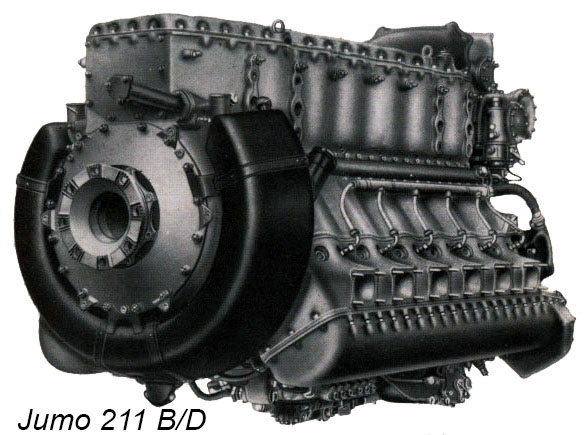The Junkers Jumo 211 was an inverted V-12 engine that was a direct competitor to the Daimler-Benz DB 601 engine. While the DB 601 was used primarily in German fighters, the 211 was the main German bomber engine during the war and used primarily in Junkers own Ju 87 and Ju 88, the Heinkel He 111 and in the twin-engine version of the Savoia-Marchetti SM.79.

The engine was designed by Dr. Franz Josef Neugebauer of Junkers Moteren. It was a scaled up version of the Jumo 210 and was first tested in 1936. The inverted twelve-cylinder, V-12 engine had a displacement of 30 liters (2,100 cu in), was fuel injected, and had three valves per cylinder. It was designed to produce 1,000 metric hp (PS) (735 kW) which is the equivalent of 1,013 standard hp (755 kW) running at 2,400 rpm.
On the Jumo 211F, provisions were made to provide supercharging and the rpm was increased to 2,600 and power increased to 1,340 PS (985 kW). An intercooler was provided on the 211J and power increased to 1,420 PS (1,044 kW). Further development on the 211P, with increased boosting and rpm increase to 2,700, led to an output of 1,500 PS (1,103 kW).

Total production of the Jumo 211 was 68,248 engines, including 1,046 test engines making it the most produced German engine of World War II.
| Specifications: | |
|---|---|
| Junkers Jumo 211P | |
| Date: | 1935 |
| Cylinders: | 12 |
| Configuration: | Vee, liquid-cooled |
| Horsepower: | 1,500 PS (1,479 hp) (1,103 kw) |
| RPM: | 2,700 |
| Bore and Stroke: | 5.91 in. (150 mm) x 6.5 in. (165 mm) |
| Displacement: | 2,135 cu. in. (35.99 liters) |
| Weight: | 1,290 lbs. (585 kg) |